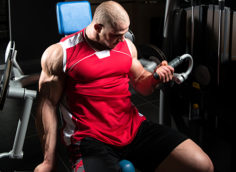Like the Sasquatch, Hardly Anyone's Ever Seen One
Most trainers will tell you to do a lat pulldown with a wide grip. At some point in their trainer gestation, they must have gotten out some crayons and construction paper, drawn a stick man, and figured that since the lats form a V, so must the arms when doing a pulldown. Hence the wide grip.
Some of them also assumed it's a bad idea to do the close-grip version because it supposedly activates your biceps more than the lats.
Then there's the behind-the-neck injury thing. Many trainers assumed that pulling the weight behind the neck causes injuries, even though, like the Sasquatch, hardly anyone in weightlifting history has seen an example of such a thing; hence the near-universal recommendation to pull to the top of the chest.
So what we're left with is an exercise that almost everybody does, or has done, but is nevertheless done in a manner that was dictated by poor logic and tradition. Two groups of scientists have come to our pulldown rescue, though.
The first group of scientists wanted to figure out which of three different types of lat pulldowns worked the lats the best. They recruited 24 men in their mid-twenties to test three different types of lat pulldowns: behind the neck pulldowns, pulldowns to the chest, and pulldowns using a V-shaped bar.
The scientists attached electrodes to test subjects' upper back muscles, their chest muscles, their shoulder muscles, and their biceps and had them perform the three varieties of pulldowns using 80% of the weight with which they could do 1 rep (their 1RM).
It turns out that the three forms activated the lats equally. The behind-the-neck version did, however, activate more posterior deltoid and more pec, while the to-the-chest version isolated the pecs more. (I've chosen to ignore the results of the extreme V-shaped bar because they're pretty rare.)
The top of the chest version, however, was deemed the best choice because the behind-the-neck version didn't isolate the upper back muscles quite as well. They also assumed, like everyone else, that the top of the chest version was safer, even though they didn't provide any evidence.
The second group of scientists recruited 12 men between the ages of 19 and 30 and attached electrodes to their biceps, lats, and traps. Then they had them perform four different types of pulldowns using 70% of their 1RM:
- Hands wide apart using a supinated grip (palms facing the body)
- Hands wide apart using a pronated grip (palms facing away from the body)
- Hands shoulder-width apart using a supinated grip
- Hands shoulder-width apart using a pronated grip
The attached electrodes told the researchers that shoulder-width and wide-grip versions activated the lats equally, while the varying grips had no significant effect on the biceps or traps.
What did matter, though, was using a pronated grip. Grasping the bar with your palms away activated the lats far better than a supinated grip.
To effectively target the lats during a pulldown, do the following:
- Use a pronated (palms away) grip.
- Pull to the top of the chest.
- Use the grip (shoulder width or wider) that feels the most comfortable.
- Lusk SJ, Hale BD, Russell DM. "Grip width and forearm orientation effects on muscle activity during the lat pull-down." J Strength Cond Res. 2010 Jul;24(7):1895-900.
- Sperandei, Sandro; Barros, Marcos A; Silveira-Jœnior, Paulo C; Oliveira, Carlos G. "Electromyographic Analysis of Three Different Types of Lat Pull-Down."
- Journal of Strength & Conditioning Research, October 2009, Volume 23, Issue 7, pp 2033-2038.





